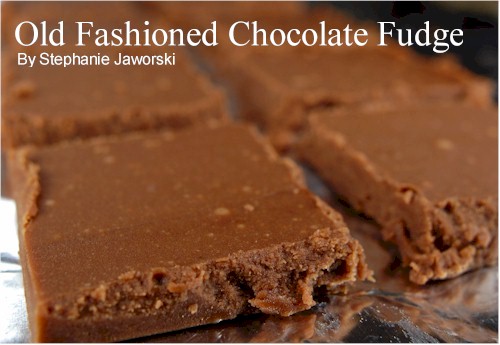|
| |
Chocolate Fudge Tested Recipe
|
Printer Friendly Page |
|

There
seems to be a consensus that fudge making began on American women's college campuses
during the 1890s. Some believe that it began from a batch of botched
caramel, hence its nickname "grained caramel". There are many opinions as to how the name "fudge" came
to be and Webster's Dictionary speculates that the name 'fudge'
refers to the fact that students making the candy were doing it in order to
"fudge" on dormitory rules. Fudge; like toffee, caramel, brittle, divinity, fondant, and pralines
begins with sugar. Other ingredients, depending on the candy, are added to
the sugar and this mixture is boiled until enough of the water has
evaporated so the sugar syrup has reached the desired concentration and
temperature. The temperature at which this syrup is removed from the heat
determines the texture of the candy (the higher the temperature the harder
the candy). To make chocolate fudge;
chocolate, corn syrup, and cream (or milk) are boiled with the sugar until the
soft ball stage is reached. (Soft ball means when you drop a little of the syrup
into ice water it will form a soft ball that will lose its shape when exposed to
the air, or if a candy thermometer is used (234 - 240 degrees F) (112 - 116
degrees C)). The fudge is then removed from the heat, butter is placed on the
surface of the fudge, and it is left to cool undisturbed
until lukewarm (about 110 degrees F) (42 degrees C). Vanilla extract and a
little salt are then added and the fudge is beaten until
creamy and smooth.
Now for a little science. Making fudge can be tricky. One of the first
rules is - Do not make candy on a humid day as this can cause the fudge to
be grainy. And then there is the problem of boiling sugar syrup tending to
crystallize. Luckily there are ways to help slow down this
crystallization. The first way is by adding corn syrup and cream (milk) to
the mixture. Another, is to brush down the sides of
the pan with cold water if there are any crystals forming, and do not stir the
syrup once it boils. Care must also be taken when cooling the
fudge as this can affect the fudge's texture and appearance. Make sure you do
not stir in the butter (just place it on top) and leave the candy thermometer in the saucepan
once you remove it from the heat so you can see when the fudge has cooled
to the desired temperature. Then, and only then, should the fudge be
beaten (to evenly distributes the sugar crystals) until it has lost its
shine and is nice and thick. If you beat the fudge before it has cooled
sufficiently the sugar crystals will be too large and hence graininess.
Store the fudge at room temperature for up to a week, or for longer
storage, it can be frozen. |
| |
|
Chocolate Fudge:
Grease the bottom and sides of an 8 x 8 x 2 inch (20 x 20 x 5 cm) pan with about 1
tablespoon (14 grams) of room temperature unsalted butter. Set aside.
In a heavy 2 1/2 -
3 quart saucepan, place the sugar, chocolate, light corn syrup, and
half-and-half. Over
medium-low heat stir the ingredients, with a wooden spoon, until it comes to a
boil. Cover the pan with a lid
for about 2-3 minutes to allow the sides of the pan to wash themselves down and
dissolve any sugar crystals. Remove lid and clamp
a candy thermometer onto the side of the saucepan and,
making sure it does not touch the bottom of the pan,
boil the mixture gently (adjust the heat as necessary) until the temperature
reaches the soft ball stage (236 degrees F) (113 degrees C). Do not stir or
shake. (Wash down the sides of the pan with a pastry brush dipped in cold water
if any granules form.)
Remove from heat
and drop the 2 tablespoons of butter on top of the fudge, but do not stir the
butter into the fudge. Allow the fudge to cool to lukewarm (110 degrees F) (38 -
43 degrees C). Remove the thermometer and add the vanilla extract and salt. Beat
the fudge (you can do this by hand with a wooden spoon or with an electric hand
mixer) until it begins to lose its shine and is nice and creamy. Pour into the
prepared pan and let cool for several hours before cutting into squares.
Store and serve at
room temperature.
Makes one 8 x 8
inch (20 x 20 cm) pan of fudge. Preparation time 45 minutes.
|
|

Chocolate Fudge Recipe:
2 cups (400 grams)
granulated white
sugar
2 squares (2 ounces)
(60 grams) unsweetened chocolate,
chopped
2
tablespoons light corn syrup
2/3 cup (160 ml)
half-and-half (or light cream)
2 tablespoons (28 grams)
unsalted
butter, cut into pieces
1/8 teaspoon salt
1 teaspoon pure
vanilla
extract
|
|
|
|
| |
| |
|